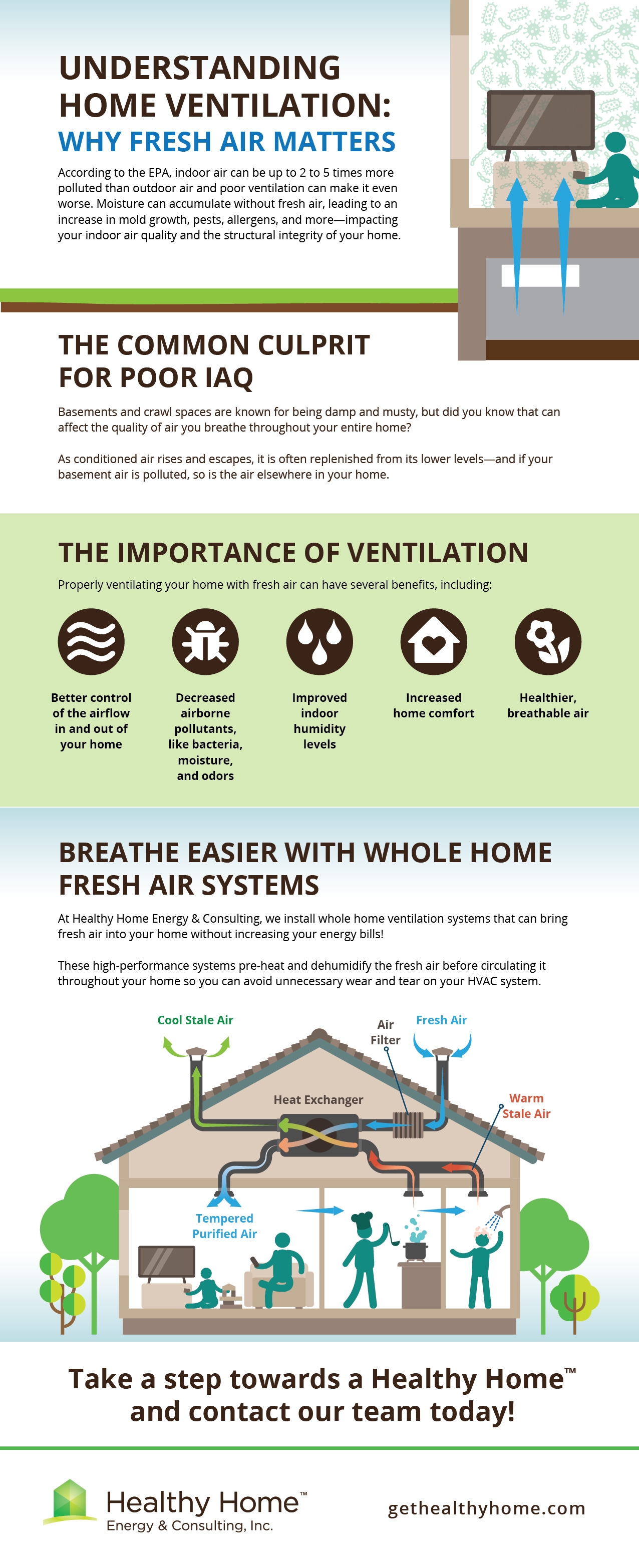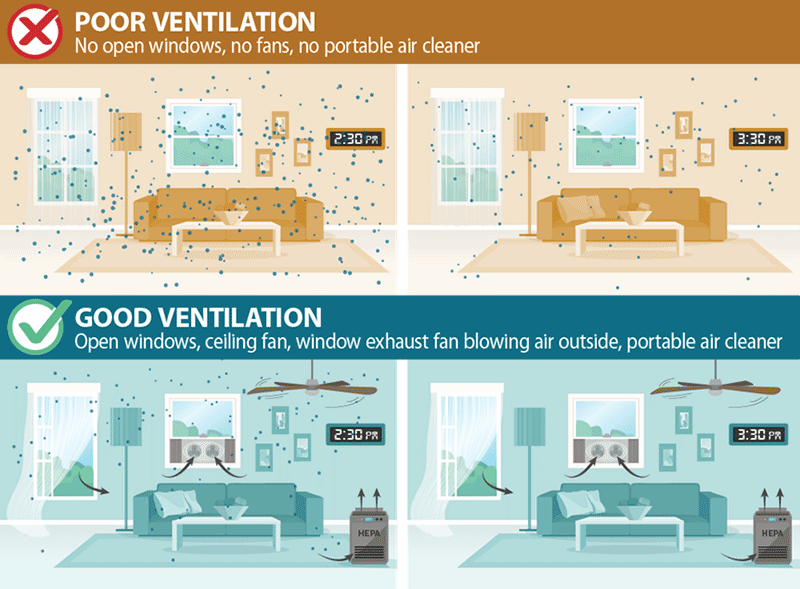Discovering Ingenious Solutions for Optimal Home Ventilation Equipments
Home air flow plays a necessary role in preserving health and wellness and convenience within living areas. With improvements in innovation, innovative remedies are arising to optimize these systems. Smart ventilation, power recuperation ventilators, and progressed filtering are reshaping exactly how air quality is handled - Home Ventilation Melbourne. Nonetheless, the assimilation of these innovations questions regarding their efficiency and flexibility in diverse home environments. What ramifications do these growths hold for future living criteria?
The Importance of Home Air Flow for Wellness and Convenience
Although frequently neglected, home air flow plays a vital function in keeping both health and convenience within property areas. Appropriate ventilation is vital for the circulation of fresh air, which assists to thin down interior toxins such as volatile natural compounds, allergens, and odors. Without correct airflow, these impurities can accumulate, resulting in respiratory concerns and various other illness. Furthermore, efficient ventilation adds to managing moisture levels, protecting against mold growth and architectural damage. By making certain a balanced exchange of air, homeowners can enjoy a more positive interior setting, enhancing overall health. Furthermore, appropriate air flow can enhance energy efficiency by minimizing the requirement for too much heating or cooling, inevitably resulting in reduced utility expenses and a much more lasting home.
Smart Air Flow Equipments: Harnessing Technology for Efficiency
Smart ventilation systems represent a significant innovation in home air monitoring, leveraging IoT combination for enhanced control. These systems not just advertise energy effectiveness however also offer remote monitoring capabilities, enabling customers to enhance their indoor settings perfectly. By utilizing innovation, property owners can accomplish enhanced air top quality while decreasing power consumption.
IoT Integration Advantages
Exactly how can IoT integration transform standard air flow systems right into highly effective smart solutions? By integrating Net of Things (IoT) innovation, ventilation systems can attain real-time tracking and control, boosting their operational performance. Sensors put throughout a home gather information on air high quality, moisture, and temperature level, permitting automated changes based upon current conditions. This immediate responsiveness brings about improved interior air high quality and comfort degrees. Additionally, IoT-enabled systems can connect with other smart home devices, developing a natural ecological community that optimizes energy usage. Individuals can also gain access to and manage their air flow systems remotely through mobile phones, supplying comfort and raised control. Overall, IoT assimilation represents a considerable innovation, bringing intelligence and versatility to typical air flow practices.
Power Performance Includes
As energy effectiveness comes to be an essential focus in modern home style, progressed air flow systems use ingenious features that greatly lower power usage. These clever ventilation systems utilize sensing units to monitor indoor air temperature, quality, and humidity levels, immediately changing air movement to keep perfect conditions. By using energy recovery ventilators (ERVs), they recycle and catch power from outward bound air, minimizing heating and cooling demands. Variable speed fans additionally boost efficiency by adjusting their operation based on real-time requirements, protecting against unnecessary energy waste - Home Ventilation Melbourne. Additionally, programmable timers and occupancy sensing units guarantee that air flow runs just when required, adding to reduced energy expenses. Jointly, these attributes stand for a significant advancement in creating sustainable and energy-efficient living settings
Remote Surveillance Capacities
What benefits do remote tracking abilities bring to modern home ventilation systems? These capacities permit homeowners to track interior air top quality and system performance in genuine time, enhancing overall efficiency. By offering data on temperature, air, and humidity pollutants, clever ventilation systems enable proactive adjustments, ensuring optimal problems. Furthermore, remote surveillance promotes upkeep informs, identifying potential concerns prior to they escalate, thereby lowering fixing expenses and downtime. Users can access system analytics through mobile applications, permitting hassle-free control even when far from home. This technical combination not only advertises energy performance however additionally adds to a much healthier living environment. Inevitably, remote monitoring abilities represent a substantial advancement in home air flow, aligning with the growing need for smart home innovations.
Power Recovery Ventilators: Making The Most Of Power Savings
Energy recuperation ventilators (ERVs) play a vital duty in enhancing home power performance through efficient warmth exchange. By transferring thermal energy in between inbound and outgoing air, these systems significantly reduce general power consumption. This ingenious strategy not just maintains indoor air top quality but likewise adds to lower utility expenses.
Performance of Heat Exchange
While preserving indoor air high quality is important for wellness and comfort, the effectiveness of heat exchange in power recuperation ventilators (ERVs) plays an essential duty in making best use of energy savings. The key function of an ERV is to move warmth and wetness in between inbound and outward bound jet stream, which maximizes interior problems while lessening power loss. High-efficiency warm exchangers can significantly minimize the tons on heating and cooling systems by reclaiming energy that would certainly or else be thrown away. The performance of these systems is frequently measured by their core temperature exchange prices, which can differ based upon style and materials used. By concentrating on innovative warmth look at this website exchange modern technologies, house owners can improve their ventilation systems, leading to boosted power effectiveness and cost decreases gradually.
Minimized Energy Intake
Minimizing energy consumption is a vital advantage of energy recuperation ventilators (ERVs), as they effectively recycle thermal power from tired air. By transferring warm between outgoing and inbound air streams, ERVs decrease the requirement for additional home heating or cooling, leading to significant energy financial savings. This process not just minimizes utility prices however additionally minimizes the environmental influence connected with greater energy usage. Furthermore, ERVs keep constant indoor air top quality without jeopardizing thermal comfort, producing a balanced living atmosphere. By integrating ERVs right into home ventilation systems, house owners can achieve greater power efficiency, allowing a sustainable strategy to indoor air monitoring while gaining from reduced energy costs. Ultimately, ERVs stand for an engaging service for energy-conscious customers.
Advanced Filtering Technologies for Cleanser Indoor Air
As indoor air high quality becomes progressively identified as a critical element of health and wellness, advanced purification technologies are becoming crucial tools for making sure cleaner environments. These technologies include high-efficiency particle air (HEPA) filters, activated carbon filters, and electrostatic precipitators, each developed to effectively capture airborne toxins, allergens, and volatile organic compounds (VOCs) HEPA filters can catch particles as little as 0.3 microns, greatly minimizing irritants like allergen and pet dander. Triggered carbon filters stand out in adsorbing odors and chemical vapors, adding to a fresher interior environment. In addition, electrostatic precipitators make use of electric costs to get rid of fragments, giving an energy-efficient choice. By incorporating these sophisticated filtering systems, home owners can boost interior air high quality and promote healthier living areas.
The Role of Sensors in Optimizing Air Movement and Top Quality
Just how can sensing units transform the management of interior air top quality? Sensing units play a crucial duty in enhancing air flow and improving interior settings. By constantly keeping an eye on elements such as humidity, temperature level, and degrees of contaminants, they provide real-time information that notifies ventilation systems. This details makes it possible for official statement automatic adjustments to air movement, making certain appropriate circulation and minimizing the build-up of pollutants. Additionally, progressed sensors can detect details air high quality issues, triggering immediate feedbacks to improve convenience and health and wellness. The integration of look here these tools into air flow systems permits an extra effective and receptive administration approach, minimizing energy intake while maintaining excellent air quality. Inevitably, sensors work as a vital part in creating much healthier interior areas via precise air movement policy.
Incorporating Ventilation With Smart Home Solutions
While several homeowners look for benefit and efficiency, integrating air flow systems with clever home innovation supplies a cutting-edge remedy to managing indoor air high quality. By attaching air flow units to wise home centers, locals can automate air high quality surveillance and control airflow based on real-time data. These systems can react to adjustments in pollutant, humidity, and temperature degrees, ensuring optimal interior problems. Smart thermostats can function in tandem with air flow systems to improve power effectiveness, lowering prices while keeping convenience. Homeowners can also remotely control their air flow settings through mobile applications, providing versatility and peace of mind. Eventually, this combination not only simplifies management but significantly improves the overall living environment, making it an important addition to contemporary homes.
Future Patterns in Home Ventilation Solutions
Emerging modern technologies and enhanced awareness of indoor air high quality are shaping the future of home air flow remedies. One substantial pattern is the combination of expert system, making it possible for systems to change air flow based on real-time information and occupancy patterns. Furthermore, power recuperation ventilators are acquiring traction, giving effective air exchange while reducing energy loss. The usage of eco-friendly products and styles is also growing, straightening with sustainability goals. Smart sensors that check toxins and humidity levels are coming to be requirement, allowing home owners to preserve suitable indoor settings. Scalable and modular systems are emerging, providing personalized choices for various home dimensions and configurations. With each other, these developments assure to enhance comfort, performance, and health and wellness in residential areas
Regularly Asked Questions
Just how Typically Should I Clean My Home Ventilation System?

The regularity of cleaning a home ventilation system differs based on usage and atmosphere. Usually, it is suggested to clean up the system every 3 to 6 months to maintain optimal air top quality and system performance.
Can Poor Ventilation Reason Mold Development Indoors?

What Are the Indications of Inadequate Home Air Flow?
Signs of inadequate home ventilation consist of relentless odors, enhanced moisture degrees, condensation on home windows, visible mold development, and a basic sensation of stuffiness. These indicators typically recommend that air blood circulation wants for preserving a healthy and balanced interior environment.
Exactly How Can I Enhance Air Flow in Older Homes?
To improve ventilation in older homes, one may take into consideration mounting exhaust followers, making use of natural airflow through windows, sealing gaps for better air control, and incorporating air purifiers to enhance indoor air quality effectively.
Are DIY Ventilation Solutions Effective and Safe?

Smart air flow, power recuperation ventilators, and progressed filtration are reshaping exactly how air high quality is handled. As energy efficiency becomes a vital emphasis in modern-day home design, advanced ventilation systems use cutting-edge features that considerably lower power intake. By incorporating ERVs into home ventilation systems, homeowners can accomplish higher power performance, enabling a sustainable method to indoor air administration while benefiting from lower energy costs. The assimilation of these devices into air flow systems enables for a much more responsive and efficient monitoring strategy, lowering power intake while keeping suitable air top quality. While several house owners look for comfort and efficiency, incorporating air flow systems with wise home innovation provides an ingenious service to managing indoor air top quality.